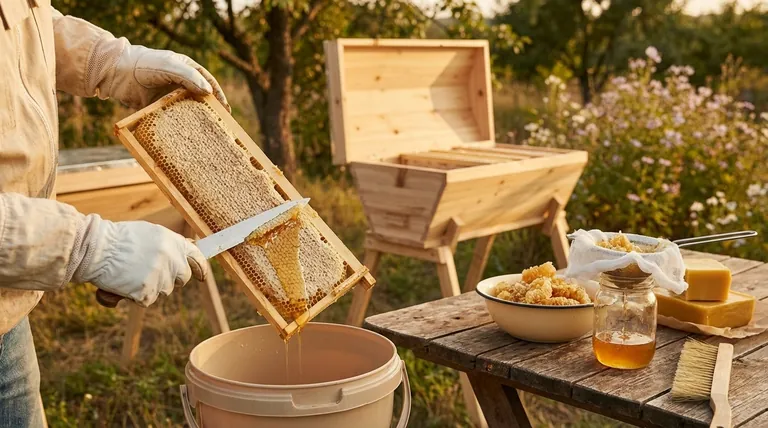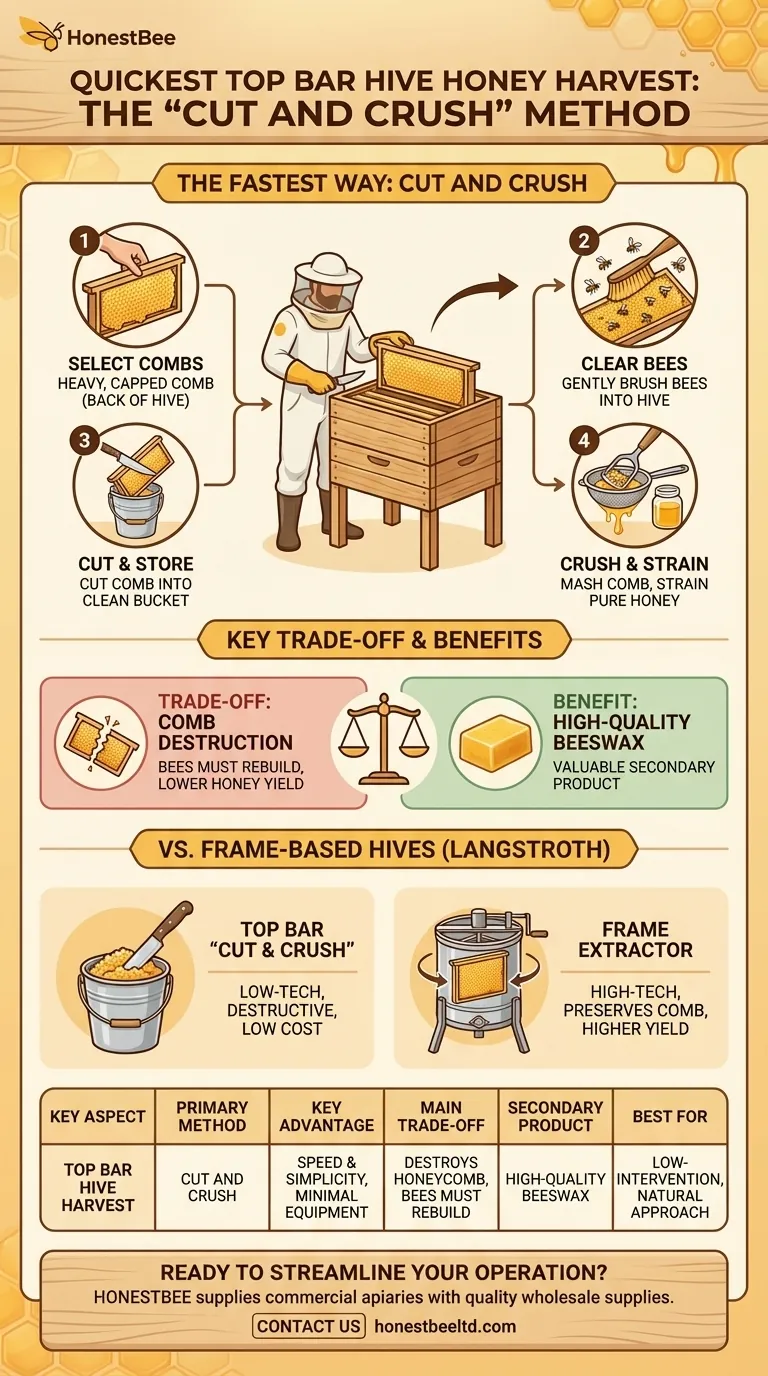The fastest way to harvest honey from a top bar hive is to physically remove a full comb, gently brush the bees off, and cut the comb from the top bar. This direct "cut and crush" method requires very little specialized equipment and can be done quickly, making it the defining harvesting technique for this style of beekeeping.
The core principle of a top bar hive harvest is its elegant simplicity. While the "cut and crush" method is unquestionably the quickest, this speed comes with a critical trade-off: the honeycomb is destroyed, forcing the colony to expend significant energy and resources to rebuild.

The "Cut and Crush" Method Explained
The speed of a top bar hive harvest comes from its low-tech, straightforward process. It avoids the complex and costly equipment associated with other hive types.
Step 1: Select the Right Combs
Your first step is to identify the combs ready for harvest. These are typically at the very back of the hive, furthest from the entrance. Look for combs that are heavy, fully drawn out, and mostly "capped" with a white beeswax layer.
Step 2: Remove the Comb and Clear the Bees
Gently lift the selected top bar and its attached comb out of the hive. Using a bee brush, softly sweep the bees off the comb and back into the hive. Work calmly and deliberately to minimize disturbance.
Step 3: Cut and Store the Comb
Once the bees are cleared, use a simple kitchen knife to cut the entire comb away from the top bar. Place the pieces of comb directly into a clean, food-grade bucket or container with a secure lid to prevent bees from accessing it.
Step 4: Crush and Strain the Honey
With the comb secured away from the hive, the final step is extraction. Mash the comb using a potato masher or clean utensil. Pour the resulting mixture of honey and wax through a simple strainer or cheesecloth set over another bucket to separate the pure, liquid honey.
Why This Method is Fundamentally Different
Understanding the top bar hive's design philosophy clarifies why the harvest method is what it is. It's a system built around a different set of priorities than the more common Langstroth hive.
The Top Bar Philosophy: Simplicity First
Top bar hives are designed for low-intervention beekeeping. The harvest process reflects this, requiring only basic tools like a knife and a bucket, rather than expensive centrifuges or extractors.
Contrast with Frame-Based Hives
In a Langstroth hive, the comb is built inside a rigid frame. A machine called an extractor spins these frames, forcing the honey out while leaving the delicate comb intact. This preserved comb is then returned to the hive, saving the bees the immense effort of rebuilding it from scratch.
Understanding the Trade-offs
The speed and simplicity of the top bar harvest method come with consequences that every beekeeper must understand.
The Cost of Speed: Comb Destruction
The primary trade-off is the destruction of the comb. A bee colony must consume a significant amount of honey (nectar) to produce the wax needed to build comb. Destroying it represents a major setback and energy cost for the bees, which can result in lower overall honey production.
The Benefit: High-Quality Beeswax
The direct result of a destructive harvest is a significant yield of clean, high-quality beeswax. This wax is a valuable secondary product that is not as easily harvested from hives where the comb is continually reused.
Honey Yield vs. Beekeeper Effort
While a top bar hive may produce less honey over time compared to a Langstroth hive, the investment in both equipment and labor from the beekeeper is substantially lower. It prioritizes beekeeper simplicity over maximum colony output.
Making the Right Choice for Your Goal
To properly time your harvest, aim for a calm, relatively warm day. The best time is often mid to late afternoon when many of the colony's forager bees are out of the hive.
- If your primary focus is speed and simplicity: The "cut and crush" method is the definitive and most efficient choice for a top bar hive, requiring no specialized equipment.
- If your primary focus is maximizing honey yield: Be aware that the top bar hive's destructive harvest limits long-term honey production compared to frame-based hives where comb is preserved.
- If your primary focus is a natural, low-intervention approach: The top bar harvest aligns perfectly, yielding both pure honey and valuable beeswax with minimal cost and complexity.
Ultimately, the quick and simple nature of a top bar hive harvest is a direct reflection of its natural-first design.
Summary Table:
| Key Aspect | Details for Top Bar Hive Harvest |
|---|---|
| Primary Method | 'Cut and Crush' |
| Key Advantage | Speed and simplicity; requires minimal equipment |
| Main Trade-off | Destroys honeycomb, requiring bees to rebuild |
| Secondary Product | Yields high-quality beeswax |
| Best for | Beekeepers prioritizing a low-intervention, natural approach |
Ready to streamline your beekeeping operation? HONESTBEE supplies commercial apiaries and beekeeping equipment distributors with the high-quality, wholesale-focused supplies needed for efficient and successful honey harvesting. Whether you manage top bar hives or other systems, our equipment is built for durability and performance. Contact our team today to discuss your wholesale needs and discover how we can support your business growth.
Visual Guide

Related Products
- Top Bar Beehive for Beekeeping Wholesales Kenya Top Bar Hive
- Long Langstroth Style Horizontal Top Bar Hive for Wholesale
- HONESTBEE Advanced Ergonomic Stainless Steel Hive Tool for Beekeeping
- HONESTBEE Professional Long Handled Hive Tool with Precision Cutting Blade
- HONESTBEE Professional Multi-Functional Hive Tool with Ergonomic Wood Handle
People Also Ask
- Why are hive inspections easier with Top Bar Hives? Achieve a Calmer, Safer Approach to Beekeeping
- What are the labor requirements for a KTBH vs. Langstroth hive? A Guide for Apiary Efficiency
- What are the advantages of harvesting honey from a top bar hive? Low-Cost, Simple Harvesting for Beekeepers
- What are the benefits of extra wax production in top bar hives? A Natural Byproduct for Craft & Efficiency
- How is honey harvested from a top-bar hive? A Guide to Simple, Low-Equipment Processing



















